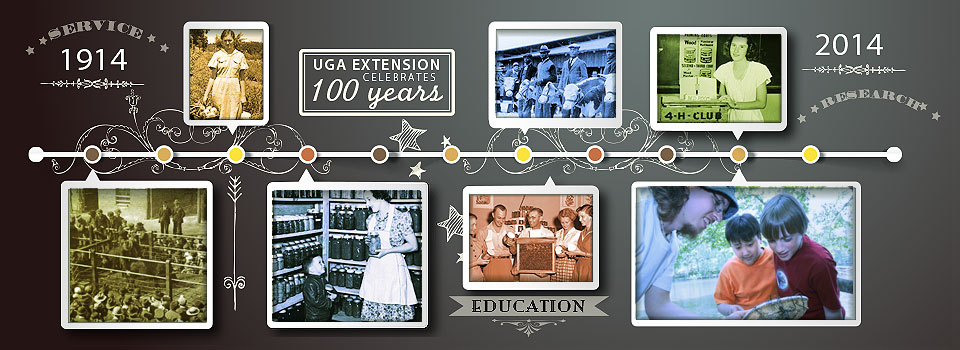UGA Extension joined with the university community and Georgians across the state last month to celebrate 100 years of community-centered information, education and service.
In May, UGA Extension celebrated its 100th anniversary with the opening of a multimedia museum exhibit in the Richard B. Russell Building Special Collections Libraries highlighting the impacts the organization has had over the past century.
“In the past 100 years, UGA Extension helped eradicate the boll weevil, introduce new food safety measures and promote land conservation,” said Beverly Sparks, associate dean of Extension in the UGA College of Agricultural and Environmental Sciences.
“Today, we face a new list of pests, problems and challenges, but we are confident our Extension experts and educators will meet them head on. We look forward to another century of service to Georgians.”
UGA Extension, originally known as the UGA Cooperative Extension Service, was officially founded in 1914 through the Smith-Lever Act, a federal law that established and funded a state-by-state national network of educators who would bring university-based research and practical knowledge to the public.
Today, Extension in the state of Georgia is a cooperative effort by federal, state and local government partners administered by the university.
“For millions of Georgia’s citizens, Extension is their connection to the University of Georgia. For a century, Extension has carried out a simple but important mission-to connect the people of Georgia with the vast resources of the university in ways that improve their lives and livelihoods,” said UGA President Jere W. Morehead. “We are proud of the impact we have across the state and pledge to continue to find ways to serve Georgians.”
In conjunction with the centennial celebration, UGA Extension has partnered with the Digital Library of Georgia to make available to the public photos taken by Extension agents and photographers through the years to help identify crop diseases, demonstrate best farming practices and document community events.
The first 1,292 photos of the collection were released this month and are available at http://dlg.galileo.usg.edu/CollectionsA-Z/caes_search.html. This first set of photos contains numerous shots of grain crops, livestock shows and forage fields from across the state. The bulk of the prints date from the 1930s to the 1960s, but some are from as early as the 1900s.
Archivists are busy scanning and cataloging the rest of the negatives and documents that are in the UGA Extension collection. Each negative sleeve contains between one and 20 negatives. The size and scope of the collection provides an excellent photographic record of Georgia folk life and farm life, said UGA archivist Caroline Killens, who is managing the project.
“What makes this collection so valuable is that many of the photos came with some type of documentation,” Killens said. “Many of these negatives came with notes about the event and subject of the photos and often with the place where they were taken and the photographer’s name.”
The centennial museum exhibit features personal anecdotes and a timeline of important events throughout the history of UGA Extension. It will travel throughout the state later this summer.
As part of the exhibit’s gala opening, Rep. Chuck Williams, R-Watkinsville, and Sen. Bill Cowsert, R-Athens, presented resolutions recognizing the centennial to Dean J. Scott Angle of the UGA College of Agricultural and Environmental Sciences and to University System of Georgia Chancellor Hank Huckaby. The resolutions, passed by the Georgia General Assembly this past winter, recognize UGA Extension as a source of timely, research-based education and information that has helped to transform Georgia’s farms, families and communities over the last century.
An expanded version of the exhibit is available online at 100years.extension.uga.edu. The dynamic website shares the history of UGA Extension through articles, pictures, videos, timelines and personal stories. The public can join in the celebration by visiting the site and sharing how Extension has touched their lives.
